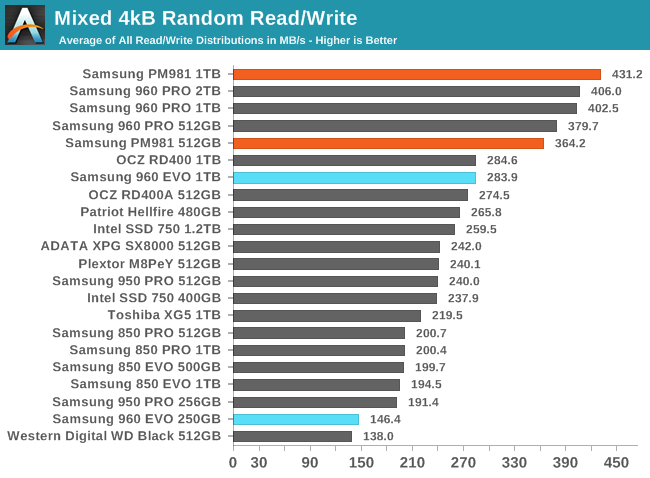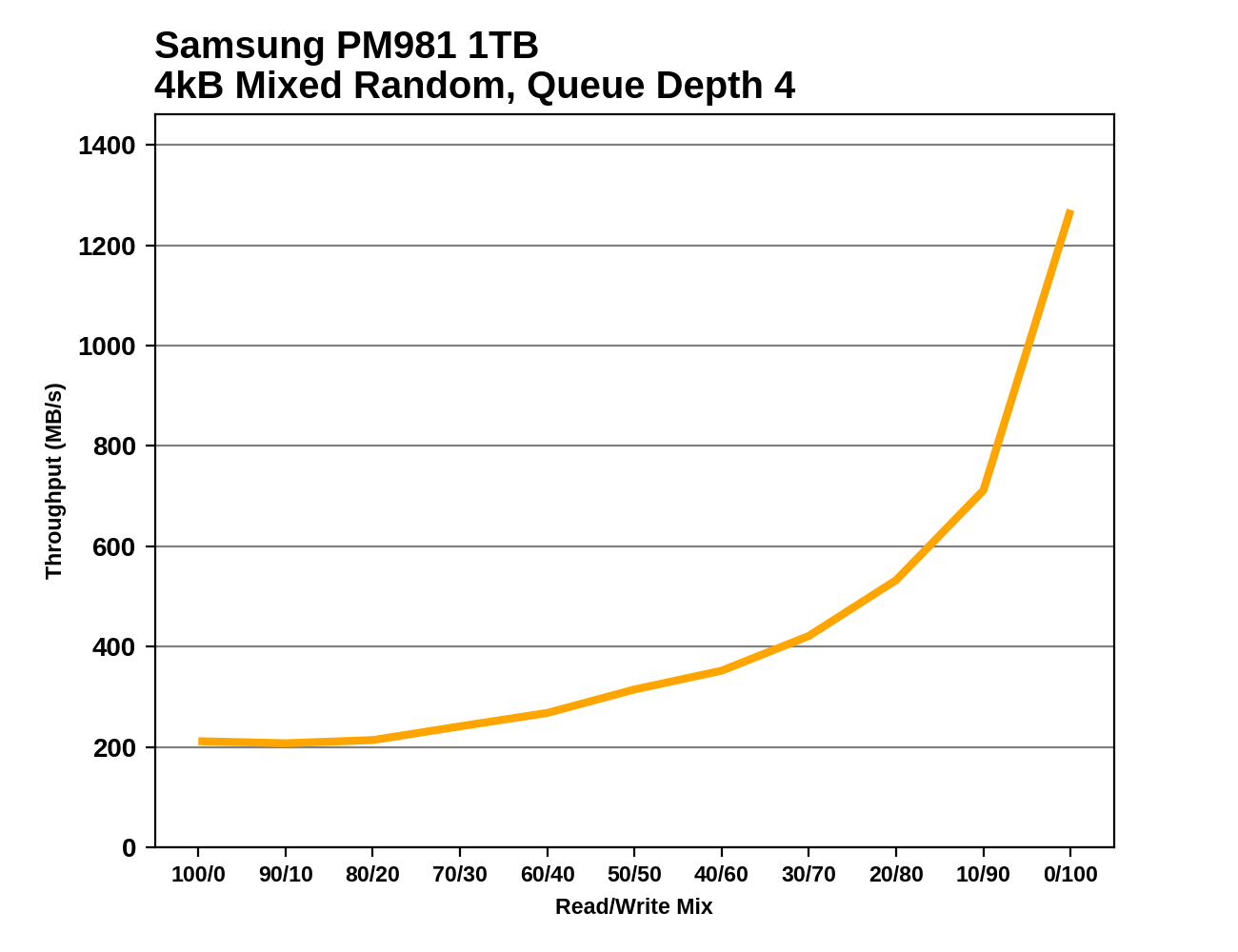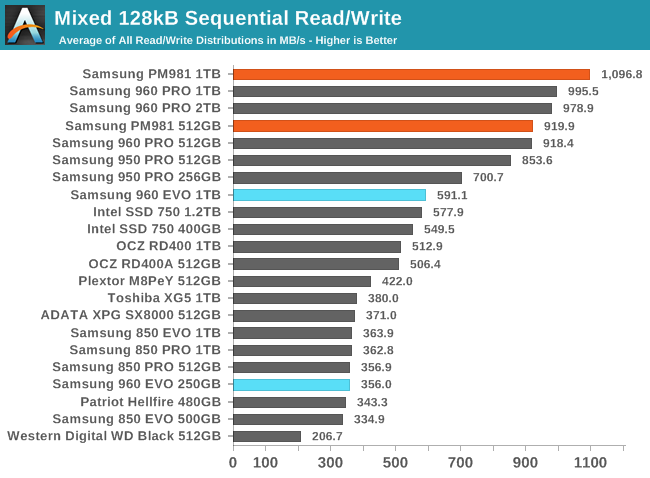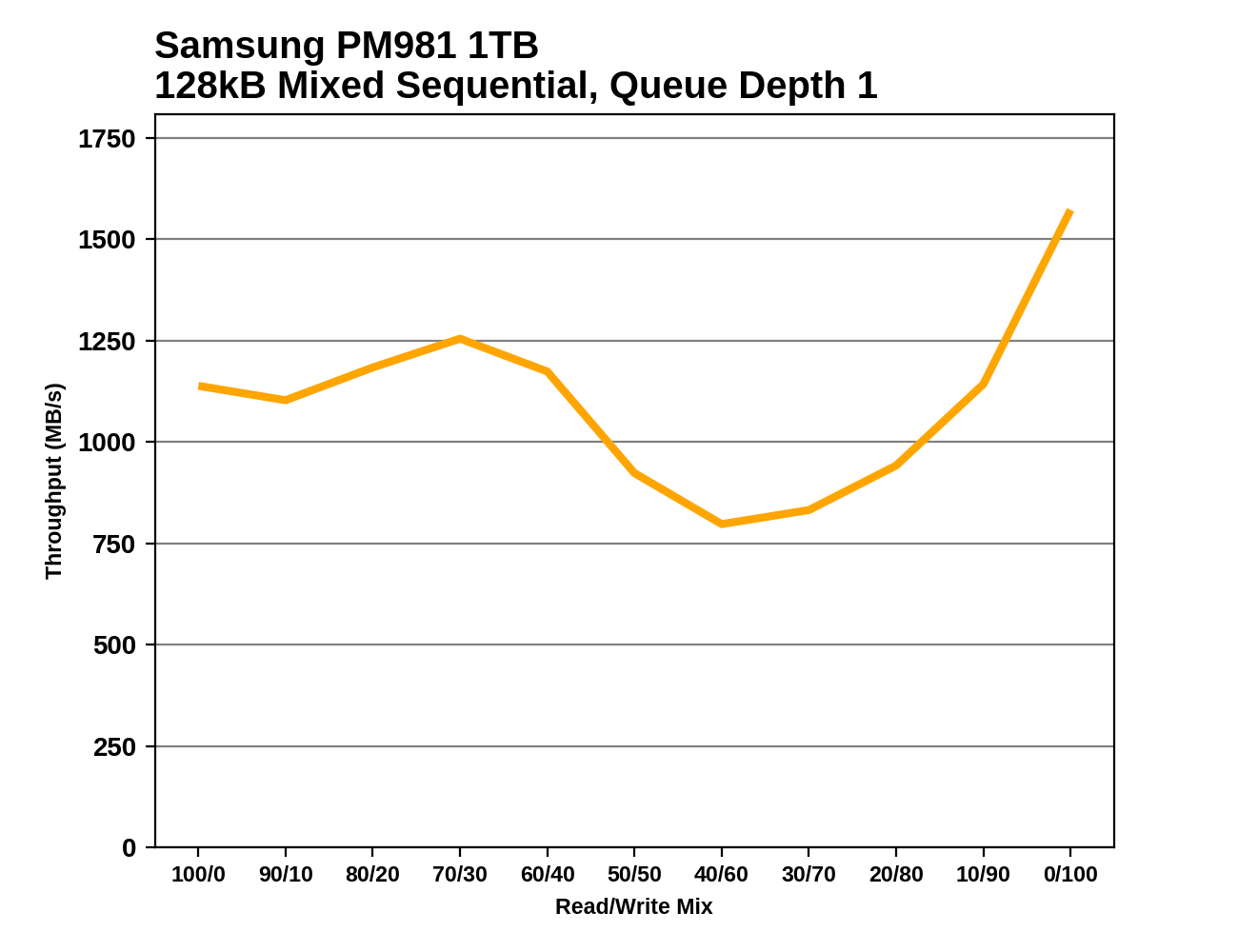The Samsung PM981 SSD Review (512GB, 1TB): Next Generation Controller And 3D NAND
by Billy Tallis on November 30, 2017 9:02 AM ESTMixed Random Performance
Our test of mixed random reads and writes covers mixes varying from pure reads to pure writes at 10% increments. Each mix is tested for up to 1 minute or 32GB of data transferred. The test is conducted with a queue depth of 4, and is limited to a 64GB span of the drive. In between each mix, the drive is given idle time of up to one minute so that the overall duty cycle is 50%.

The mixed random I/O performance of the Samsung PM981 is a big improvement over last generation's 960 EVO. The 1TB PM981 beats out even the MLC-based 960 PRO, while the smaller 512GB PM981 is a bit slower than the 960 PRO of the same size.
 |
|||||||||
As the proportion of writes in the mixed workload increases, the PM981 steadily gains performance, pulling further and further ahead of the 960 EVO. The 512GB PM981's main weakness is that its performance doesn't hit quit as high a peak during the final phases of the test when the workload is almost entirely random writes.
Mixed Sequential Performance
Our test of mixed sequential reads and writes differs from the mixed random I/O test by performing 128kB sequential accesses rather than 4kB accesses at random locations, and the sequential test is conducted at queue depth 1. The range of mixes tested is the same, and the timing and limits on data transfers are also the same as above.

The 512GB PM981 matches the mixed sequential performance of the MLC-based 512GB 960 PRO, while the 1TB PM981 is substantially faster than the 960 PRO or any other flash-based SSD.
 |
|||||||||
The Samsung 960 PRO 1TB outperforms the 1TB PM981 during the early read-heavy phases of the mixed sequential test, but then its performance drops off precipitously while the PM981 retains its performance until later in the test. The 512GB PM981 averages almost exactly the same performance as the 512GB 960 PRO, but with substantial differences in the details: the 960 PRO is faster at either end of the test, but the PM981 has a significant advantage for more even mixes of reads and writes.










53 Comments
View All Comments
tsk2k - Thursday, November 30, 2017 - link
It's all about that 3D-Xpoint nowadays.rsandru - Thursday, November 30, 2017 - link
Speaking of which, can we have the Optane 900p data points back in?boeush - Thursday, November 30, 2017 - link
Hmm, yeah - all about 1 TB 3D XPoint - how much would that cost, again, and what's the retail availability of the M2 form-factor?ddriver - Thursday, November 30, 2017 - link
Unfortunate after so many years of complete domination samsung is not even trying anymore. It will be TLC all over in order to squeeze out every cent worth of profit from that advantage.Spunjji - Thursday, November 30, 2017 - link
"...the PM981 has caught up to or surpassed the MLC-based 96x drives on many tests, setting new records not just for TLC-based drives but for client SSDs as a whole."Right; they're clearly not trying at all. :|
mapesdhs - Thursday, November 30, 2017 - link
"...in order to squeeze out every cent worth of profit from that advantage."That's called business. If rivals don't like it, they should make something better and bring it to market. I might not like how Samsung has managed its pricing, etc., but if I were them, then based on fiduciary duty to shareholders I would do exactly the same thing.
ddriver - Thursday, November 30, 2017 - link
They are not, but it requires north of a simpleton's way of looking at it to see it. Because they could have kept MLC and offered a significant boost in performance thought the entire drive.And the claim that using TLC it catches up on MLC drives is just nonsense. There is no engineering miracle here. There is simple caching at play, the drive doesn't touch TLC for the duration of AT's flimsy test suite. Once the drive runs out of cache performance quickly gets abysmal - about 750 mb/s once it gets to the point of using TLC directly. Not to mention the reduced endurance.
Granted most casual consumers won't be doing anything as data intensive, but many prosumers will, which means that current consumer grade drives are no longer adequate for prosumer applications, which wasn't the case with the previous generation, indicating that samsung is indeed taking a step back.
And things are not looking too well in the more affordable enterprise range neither, its lousy with TLC as well. Meaning that samsungs devolution now forces prosumers to shop for the much more expensive high-end enterprise storage solutions.
I don't mind TLC. What I mind is depriving the market of MLC. I didn't mind paying the MLC premium for the 960 PRO over the EVO. It was a good deal. I mind that they are taking that deal away from the market. And if you had 2 properly working brain cells you'd mind that too.
MFinn3333 - Thursday, November 30, 2017 - link
"There is simple caching at play, the drive doesn't touch TLC for the duration of AT's flimsy test suite."What? Here is the destroyer benchmark's description...
Total GB Read: 1583.02 GB
Total GB Written: 875.62 GB
Total IO Operations: 49.8 million
Queue depth is 50% 1 depth.
What is your definition of flimsy?
mkaibear - Friday, December 1, 2017 - link
This is deedee, his definition of "flimsy" is "if there is any possible way in which I can be right, then I meant that".ddrіver - Thursday, November 30, 2017 - link
Exactly. The products are better because time passes on and technology advances, not because they are actually struggling to make them better. Profit is their number one concern performance just happens to increase from time to time...